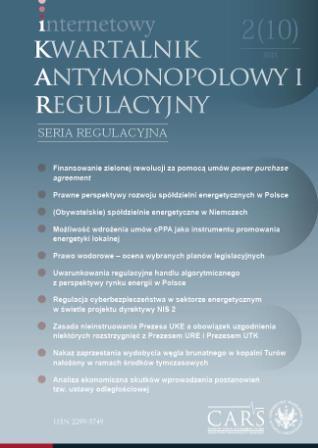Analiza ekonomiczna skutków wprowadzenia postanowień tzw. ustawy odległościowej oraz korzyści z planowanej zmiany regulacji dotyczących rozwoju lądowej energetyki wiatrowej
Economic Analysis of the Effects of the Introduction of Poland’s so-called ‘Distance Law’ and the Benefits of the Planned Change in Polish Legislation on the Development of Onshore Wind Energy
Author(s): Andrzej CylwikSubject(s): Energy and Environmental Studies, Environmental and Energy policy, Law on Economics, EU-Legislation
Published by: Wydawnictwo Naukowe Wydziału Zarządzania Uniwersytetu Warszawskiego
Keywords: Amendment of the Distance Law; removal of the restriction on onshore wind energy development; RES crisis in 2017-2019; losses caused by wind energy inhibition; scenarios for resumption of wind energy;
Summary/Abstract: The purpose of the economic analysis presented was: (1) calculating the losses caused by the introduction of the so-called Distance Law and inhibition of the development of domestic onshore wind energy; estimating the potential for domestic onshore wind energy growth, following a reasonable amendment to this law, which was planned for early in the fourth quarter of 2020. The author has attempted to gather as much source data as possible obtained directly from wind farm investors and developers, as well as internal cost and financial findings of the Polish Wind Energy Association. According to conservative calculations, the slowdown of wind power in 2017–2019 resulted in a reduction of investment projects by 3400 MWe, which in turn reduced potential demand and ultimately resulted in a loss of 9.317 billion PLN. The expected resumption of domestic onshore wind development between 2021 and 2030 was estimated under three scenarios: (1) reference – no changes to the Distance Law, (2) gradual growth – assumes an amendment to the law and a moderate rate of new investment, (3) comprehensive development – assumes the amendment of the law and acceleration of new investments. In the reference scenario, investments locked in during the crisis period (2017-2019) would be realized between 2021 and 2025, but onshore wind growth would be extinguished in the second half of this decade. In the gradual growth scenario, the additional increase in installed capacity will amount to 3,000 MWe, which would generate 9.545 billion PLN of direct domestic economic benefits (GDP growth). In the comprehensive development scenario, the additional installed capacity would be twice as large (6,000 MWe), and the GDP growth would amount to 19.732 billion PLN. In conclusion, the author points out that further delays in unblocking the development of onshore wind energy in Poland pose a real threat to the completion of national goals in terms of the EU climate and energy policy.
Journal: internetowy Kwartalnik Antymonopolowy i Regulacyjny (iKAR)
- Issue Year: 10/2021
- Issue No: 2
- Page Range: 120-136
- Page Count: 17
- Language: Polish

